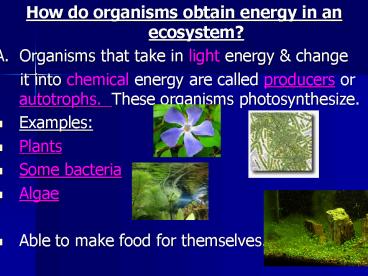How do organisms obtain energy in an ecosystem? - PowerPoint PPT Presentation
1 / 19
Title:
How do organisms obtain energy in an ecosystem?
Description:
How do organisms obtain energy in an ecosystem? A. Organisms that take in light energy & change it into chemical energy are called producers or autotrophs. – PowerPoint PPT presentation
Number of Views:342
Avg rating:3.0/5.0
Title: How do organisms obtain energy in an ecosystem?
1
- How do organisms obtain energy in an ecosystem?
- A. Organisms that take in light energy change
- it into chemical energy are called producers
or autotrophs. These organisms photosynthesize. - Examples
- Plants
- Some bacteria
- Algae
- Able to make food for themselves.
2
- B. Organisms that must eat other organisms to
- get their energy are called consumers or
heterotrophs - Come in three types
- Herbivores Eat plants (not animals)
- Examples Deer, cow, giraffe
- Carnivores Eat animals
- Examples Wolf, shark, tiger
- Omnivore Eat plants animals
- Examples Bear humans
3
- C. Organisms that get their energy from the
- energy that is locked inside dead organisms
are called decomposers or detritivores - Examples
- Hyenas
- Fungi
- Bacteria
4
- How do ecologists map out the energy flow in an
ecosystem? - To understand how energy flows through an
ecosystem scientists study feeding relationships,
or what eats what. Each step is called a trophic
level. - The first level is always made of
producers/autotrophs, which produce their own
food, from the energy they take in. - All other levels are made up of
consumers/heterotrophs, which get their energy or
food from the previous level.
5
- A food chain is a model or drawing that shows how
energy passes through an ecosystem (by showing
what eats what) - The flow of energy is
- always one way.
- Draw
6
- A bunch of interconnecting food chains in an
ecosystem make up a food web. It shows all
possible feeding relationships in an ecosystem. - Draw
7
- Food Web animation
8
- What is an ecological pyramid?
- An ecological pyramid is another way to show how
materials move through an ecosystem. - Each level represents a trophic level
- Come in 3 types or forms pyramid of energy,
pyramid of biomass pyramid of numbers
9
- Pyramid of Energy
- Indicates the amount of energy available to each
trophic level. - 10 of the energy taken in by the organisms at a
level is available to be passed on to the next
level - 90 of the energy taken in by the organisms at a
level is used by the organisms to live - Called the 10 Rule
10
- The same pyramid structure can be used to
represent the biomass or the number of each
organism at each trophic level in an ecosystem. - In a healthy and stable ecosystem, as you move up
the pyramid each block should get smaller. - What would happen if this wasnt true? What if
there were more carnivores than there were
herbivores?
11
- Recycling of Matter in Ecosystems
- Matter, atoms, can not be created or destroyed.
They are constantly being reused or cycled
through the biosphere. - Nutrients, which are made of matter, cycle
through the ecosystem are passed from organism
to organism - Taken in when organisms eat breath in
- Given off in waste? (pooping breathing out)
- Given off when they die and are decomposed
- Passed on when eaten by other organisms
12
- Some of the major substances that cycle through
our ecosystems are - water
- carbon
- oxygen
- nitrogen
13
- Carbon Oxygen Cycle
- Carbon oxygen cycle together through the
ecosystem. - Producers (plants) take in carbon dioxide (CO2)
water (H2O) and give off oxygen (O2)as waste. - Consumers (animals) breath in oxygen (O2) and
eat plants animals to take in both carbon
oxygen. - Animals give off carbon dioxide (CO2)when they
breathe out. Carbon oxygen are also released
in the ecosystem when they go the bathroom or die
decompose.
14
(No Transcript)
15
(No Transcript)
16
- Nitrogen Cycle
- Organisms need nitrogen to make proteins which
build muscle and bone. - 78 of the air is made of nitrogen BUT most
organisms can not take in nitrogen directly from
the air. - Some bacteria can take nitrogen from the air and
change it into a different form of nitrogen that
can be taken in by plants. - These bacteria can live in water, soil and roots
of some plants called legumes - Examples of legumes clover, peas,
- beans, alfalfa
17
Nitrogen Fixation is the process of taking
nitrogen in the air and changing it into a form
that plants and animals can use
18
- Plants take in the nitrogen from the soil and can
pass it on to animals when eaten. - Nitrogen from dead decaying organisms waste
goes back into the soil so it can be taken up by
plants again. - Humans can add nitrogen to soil by putting
man-made fertilizers or manure on the soil.
19
(No Transcript)































